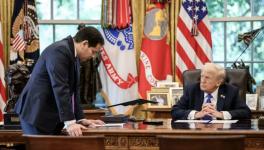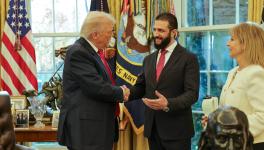The American Election: Federal Experiences of Two Democracies
Image for representational use only.Image Courtesy : HuffPost India
America’s presidential election is around the corner. Though a routine political event, its significance is much wider. Whatever we may say about the fading shine of America as a superpower, its worth as an underwriter of global order remains undeniable. Unsurprisingly, therefore, who will become the next President of the United States is speculated upon all over the world with a share-market level of curiosity.
The election is slated for 3 November. The process, however, has already begun with what is called “early voting”. The system has been designed to accommodate those voters who may, for one justifiable reason or another, find it difficult to vote on the day of election. Many Western democracies, as well as Thailand, follow this practice. Although not designed with COVID-19 in mind, early voting has been welcomed by many who worry about the added risk of exposure because of crowding on voting day. According to the Washington Post, until 19 October about 36 million Americans had availed themselves of the early voting option, which accounted for 76% of the total early votes registered in the 2016 election.
America is essentially a two-party system and the result will effectively be known on 3 November itself. But because the process is technically indirect, the official outcome will not be arrived at until votes in the Electoral College are tallied on 14 December. And it is only on 6 January 2021 that the result will be formally announced and on 20 January that the new presidency will be inaugurated.
The American system is structured in such a way that the candidate who gets the higher number of popular votes may not necessarily win the election. In the 2016 election, Hillary Clinton polled 2,868,686 votes more than Donald Trump. Still, the latter won because he got 304 electoral votes compared to Clinton’s 227. All those in India who think that the American-style presidential system is the cure for India’s problem-afflicted parliamentary system should do their homework better.
It is intriguing why the Americans have retained this faulty system from as early as 1789, when their first president, George Washington, was elected. The answer is to be found in the nation’s unflinching faith in federalism. America has gifted to the world not only its first written constitution, but also federalism as a model of government.
In the late 18th Century, when the thirteen British colonies (represented today by the number of stripes in the American national flag) decided to fight their colonial master, they did so without a clear notion about how to politically organise themselves if they succeeded in driving the British out. Being ethnically diverse for having seen different waves of immigration from Europe, these colonies were often suspicious of one another, their common cause against Britain notwithstanding.
In 1783, they defeated the British and four years later drafted their constitution. To accommodate their mutual suspicions, however, they had to work out two complex compromises. The larger colonies wanted the president to be elected through popular votes so that they could control political power. This was known as the Virginia Plan. The smaller colonies, ever suspicious of their bigger counterparts, demanded that each colony be considered equal so that everyone’s interests were protected. This was known as the New Jersey Plan.
The impasse was resolved through the creation of a bicameral legislature, that is, the United States Congress. The lower house, the House of Representatives (popularly called Congress), would satisfy the principles of the Virginia Plan, while the upper house, the Senate, would meet the ideals of the New Jersey Plan. It is this history that explains why the Senate in the United States is the most powerful “second chamber” in the world.
The Electoral College which was improvised to elect the president would comprise the total membership of the House of Representatives plus the total membership of the Senate. Later, the District of Columbia, that is, Washington DC, the capital, was permitted to send three members to the House of Representatives, albeit with restricted voting rights. At present, the Electoral College has 538 members: 435 (House Representatives) plus 100 (Senators) plus three (Representatives). At first glance this division may appear to favour the House, but we should note that 12 of 50 American states are so thinly populated that they each send just one or two Representatives to the House but elect as many as 24 Senators.
There was one other important form of legislative engineering during this period. The question arose as to what ought to be done about the millions of slaves in American society. The southern states, where most of the slaves were located, wanted the number of their seats in the House to be decided by counting these slaves as well. But the northern states wanted them to be excluded for the purposes of census so that they could outmanoeuvre the slave-owning states, primarily to protect their economic interests. Neither side asked for the slaves to be treated as equal American citizens.
This controversy was resolved through a three-fifths compromise. Irrespective of the number of slaves in any particular state, for the purposes of the census, every five slaves would be counted as three citizens. This calculus would then be used to determine the size of representation in the House of Representatives. It was as a result of such machinations that the state was enshrined as a fundamental unit of political power.
And it is for this reason that although most of the national-level polls predict a much larger vote share for Democratic challenger Joe Biden, the result of the election itself is far from a foregone conclusion. Recent history is a useful reminder. Biden and his team know well from the Clinton-Trump election of 2016 that a popular landslide may yet prove insufficient in securing the Electoral College. There can be other technical complications as well, as was exemplified by Democrat Al Gore’s loss to Republican George Bush Jr. in 2000. Although Gore had polled half a million more votes than Bush, the latter got the support of 30 states vis-à-vis Gore’s 20. Still, the Electoral College votes were split virtually down the middle: Bush got 271 against Gore’s 267 (the victory mark was 270).
A complex legal battle ensued over whether there ought to be a recount in Florida, where the margin of Bush’s victory was wafer thin. To this day, many think that in not pushing his legal case for a recount more aggressively, Gore behaved in much too gentlemanly a manner. My personal take on the matter is that Al Gore is one of the greatest democrats produced in recent times. His dignified acceptance of the legal verdict following a complicated tug of war over electoral laws underlined his commitment to established rules and regulations, which should be the essence of democracy.
When it comes to national power-sharing in a federation, therefore, what matters most is whether and to what extent the rights of constituent states are respected and protected. America’s democracy passes the test reasonably well, although there is in recent years a worrying tendency towards White supremacism, concentration of power in office of the President, and a tilt towards plutocracy. There are, of course, other problems too, none more dangerous than the phenomenon of post-truth and the manipulation of social media, trends ably identified by the recent Netflix documentary, The Social Dilemma. One may recall that one of Trump’s 2016 campaign managers had the audacity to say: “I have no obligation to be honest with the media.”
Since India is also a federation, albeit the phrase used in the Constitution is “Union of States”, where does it diverge from and converge with the United States? Here are some simple comparisons. During the last 73 years (that is, since 1947) India and America have each elected almost the same number of people as their prime minister or president: India 14, America 13. But in the case of India, its biggest state, Uttar Pradesh, which accounts for 16.5% of India’s population, has supplied as many as nine of them.
Even Prime Minister Narendra Modi, who has a huge popular base in Gujarat, decided to contest the 2014 and 2019 general elections from Varanasi in Uttar Pradesh. His political compulsions were, one, to show his all-India acceptance; and two, to represent the traditionally powerful Indian state. In contrast, America’s biggest state, California, accounting for almost 12% of the nation’s population, has given them only two presidents: Ronald Reagan and Richard Nixon.
From an obverse perspective, two of America’s smallest states, Kansas and Arkansas, each with a less than 1% share of total population, have given two presidents who each completed full eight-year terms: Dwight D. Eisenhower and Bill Clinton, respectively. Now, can one imagine an Indian prime minister from a state whose share in India’s population is 1% or less? There are ten such states (out of 28): Arunachal Pradesh, Goa, Himachal Pradesh, Manipur, Meghalaya, Mizoram, Nagaland, Sikkim, Tripura, and Uttarakhand.
Over the years there is a tendency in both the federations towards incremental centralisation. The trend is more clearly visible in India, although Americans also often talk about the perils of an Imperial Presidency. The most visible evidence of the centralising tendency in India is the recent emasculation of Article 370, which has reduced the only Muslim-majority state of Jammu and Kashmir into two non-states (Union Territories). The introduction of a one-tax regime for the entire country through the Goods and Services Tax (GST) is yet another example of the same tendency.
Speaking politically, it may be noted that federalism in India got off to a healthy start under the leadership of Jawaharlal Nehru because many state leaders of the early years were themselves powerful figures, having participated in the nationalist movement shoulder to shoulder with Nehru. Stalwarts like BG Kher of Bombay (present Maharashtra and Gujarat), BC Roy of West Bengal, Sri Krishna Sinha of Bihar, Govind Ballabh Pant of Uttar Pradesh, Gopinath Bordoloi of Assam, and many others, accepted Nehru’s leadership but did not behave as his minions.
But since the days of Indira Gandhi the picture has changed. Most state leaders now are beholden to the central command and can remain in power so long as they satisfy the latter. Today, under the leadership of Prime Minister Narendra Modi, the tendency is even more visible. In our school days too we used to read that state governors were the watchdogs of central interest, but what has changed now is that the governors have become the watchdogs of party interest; party here meaning, of course, the party in power at the Centre. One may mention the recent roles of the Maharashtra and West Bengal governors in this regard.
One last point. Federalism is not an end in itself. Let us not forget that had America strictly followed its federal textbook there would have been no United States today. The American Civil War (1860-65) would have split the nation in two. A couple of decades prior to the event, Alexis de Tocqueville, the French traveller who wrote a magnificent commentary on contemporary America, had said: “A nation that asks nothing of government but the maintenance of order is already a slave in the depths of its heart; it is a slave of its well-being, ready for the man who will put it in chains.”
What is in danger, therefore, whether it is America or India, is not merely federalism, but the idea of democracy itself. Mark Twain, with characteristic humour, had said, “It is by the goodness of God that in our country we have those three unspeakably precious things: freedom of speech, freedom of conscience, and the prudence never to practice either.”
The author is a senior fellow at the Institute of Social Sciences, New Delhi. He is a former ICSSR National Fellow and professor of South Asian Studies at JNU. The views are personal.
Get the latest reports & analysis with people's perspective on Protests, movements & deep analytical videos, discussions of the current affairs in your Telegram app. Subscribe to NewsClick's Telegram channel & get Real-Time updates on stories, as they get published on our website.























